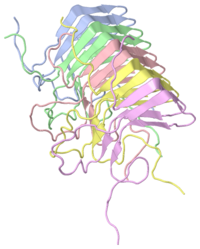User:Claire Roudot/Sandbox 1
From Proteopedia
|
Amyloid Fibrils of the HET-s(218-289) Prion Form
The HET- protein from the filamentous fungus Podospora Anserina has a prion forming domain from residues 218 to 289.
Prions are proteins Prp-sc and they can get an unasual withdrawal, whose can been transmit to the natural protein Prp-c.
Prions are often implicated in disease such as Creutzeld Jakob disease in humans, it can be also found in yeast and filamentous fungi (in this case it is harmless).
This Podospora Anserina fungus lives in genetically compatible colonies and share cellular contents such as nutriments and cytoplasm. A natural system of proteins helps incompatibility protection and prevent promiscuous between different colonies. The protein HET-S is one of them and it adopts a prion-like form in order to function properly.[1] The prion form of HET-S spreads rapidly throughout the cellular network of a colony and can convert the non-prion form of the protein to a prion state after compatible colonies have merged.[2] However, when an incompatible colony tries to merge with a prion-containing colony, the prion causes the "invader" cells to die, ensuring that only related colonies obtain the benefit of sharing resources.
It means that the prion form of HET-s plays a role in heterokaryon incompatibility, a fungal self/nonself recognition phenomenon that prevents different form of parasitism.
The prion proteins of fungus in their infectious form makes some fibrillar structures which are very hardy and are called amyloid fibrils. This amyloid fribrils are protein structures that is also found in a human neurodegenarative diseases as Parkinson disease or Alzheimer disesase.
Structure
The global organization of the HET-s (218-289) fibril is a left handed β solenoid with two windings per molecule. The studies of this part of molecule have been done with NMR.
HET-s (218-289) is formed by four ,each strand is formed by two parallel with short HN-Hα contacts (3,0A). constitute the core of the fibril. The is outside the core and is formed by β2b and β4b.
The segments () have an approximately rectangular kink between them thanks a connection by a two-residue β arc, changing the inside-outside pattern of side chains. The connection between (and similarly, between ) is linked by a three-residue β arc, allowing for the orientation change of the polypeptide backbone by ~ 150°. The β-sheet pattern is disrupted between , leading to ~90° arcs. β1-β2 and β3-β4 are pseudo repeats and linked by parallel intramolecular and intermolecular , as follows: β1a-β3a, β1b-β3b, β2a-β4a, β2b-β4b.
The first three β strands of each pseudo-repeat realized a triangular hydrophobic core, which is tightly packed, where almost exclusively are contained (Ala, Leu, Ile and Val). These strands created a very dense packing where water is quite exclude. In contrast, all face outside and are mostly located in arc β-arc regions, where the solvent accessibility is high. Three of them are arranged on top of each other such that charges are compensated and the formation of salt-bridges becomes possible. Because the stacking is parallel, it may have intra- and intermolecular charge compensation This may explain why fibrils have high stability against denaturation by non-ionic urea at neutral pH, but are destabilized by urea at acidic or basic pH.
The structure of HET-s(218-289) with its overall β-helical fold is more complexed than that of peptide fibril- this complexity is often is soluble proteins. This complex alternance of pseudo-repeat (β1/β3 and β2/β4) permits the alternation of positive and negative charges along the fibril axis, and also having a molecule forming two turns of the solenoid.
The triangular hydrophobic core formed by three stands has some resemblance with β-solenoid structures of soluble proteins like filamentous hemagglutinin protein. In this case, the periodicity does not exist but he triangular core is quite similar. A β-solenoid fold has also been proposed for the prion state of human prion protein Prp.
Consequences of the structure on the amyloid fibril
The structure determination of the infectious form of prion proteins, and especially the determination of the infectious withdrawal is very difficult because amyloids can not be studied by usual protein determination techniques.
The protein areas which take a β-sheet withdrawal could have been delimited and it has been shown that they are linked to the infectious capacity. So this work by institutes of Bordeaux and Zurich is a big steep in the determination of structural basis in prion proteins in infection.
This well-organized structure of the HET-s prion fibrils is the cause of the high order in these fibrils as well as the absence of polymorphism caused by different underlying molecular at physiological pH conditions. Indeed interaction between charges in the fibril gives a high stability, so polymorphism is excluding. The fibril structure of HET-s (218-289) along an axe amplified the well-defined structure of a functional amyloid.
References
- ↑ Paushkin, S. V., V. V. Kushnirov, V. N. Smirnov and M. D. Ter-Avanesyan (1996). "Propagation of the yeast prion-like PSI+ determinant is mediated by oligomerization of the SUP35-encoded polypeptide chain release factor". EMBO (European Molecular Biology Organization) Journal 15, 3127–3134
- ↑ Shewmaker F, Wickner RB and Tycko R, Proc Natl Acad Sci U S A. 2006 Dec 26;103(52):19754-9
Wasmer C, Lange A, Van Melckebeke H, Siemer AB, Riek R, Meier BH. Amyloid fibrils of the HET-s(218-289) prion form a beta solenoid with a triangular hydrophobic core. Science. 2008 Mar 14;319(5869):1523-6[1]. PMID:18339938
Text of CNRS [2]

